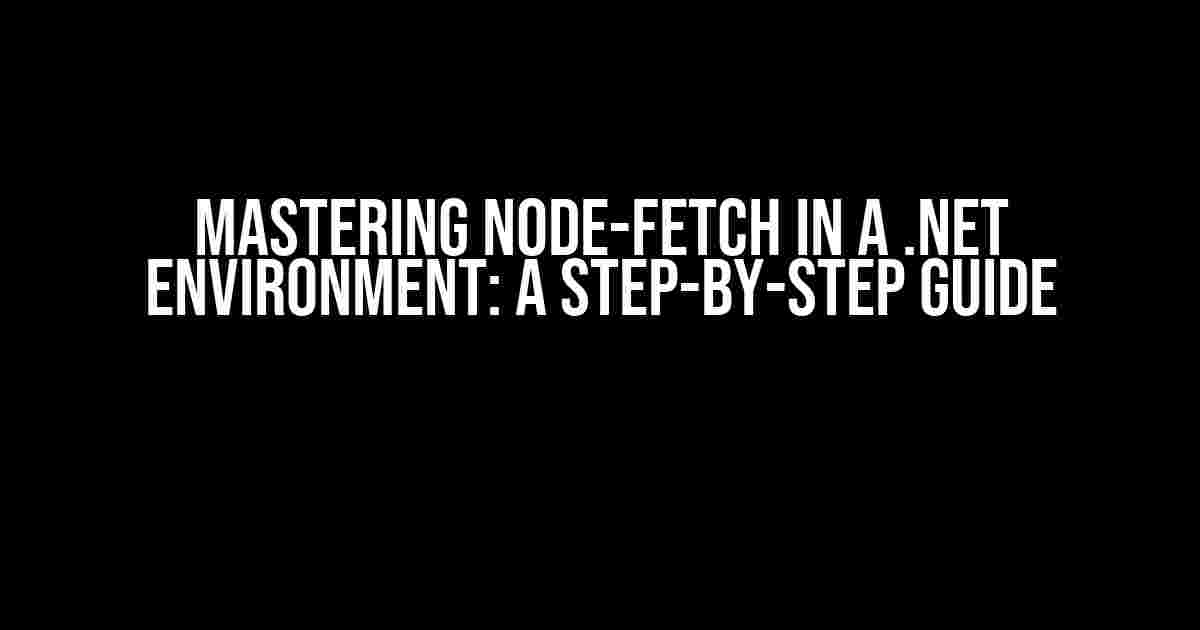Are you struggling to call node-fetch correctly in a JavaScript script executed through .NET using Jurassic? You’re not alone! Many developers face this challenge, but worry not, dear reader, for we’re about to embark on a journey to conquer this hurdle together.
What is Node-Fetch and Why Do We Need It?
Node-fetch is a popular JavaScript library that allows us to make HTTP requests in a Node.js environment. It’s a crucial tool for interacting with web services, fetching data, and sending requests. However, when working with .NET and Jurassic, things can get a bit tricky.
The Problem:Calling Node-Fetch in a .NET Environment
When executing a JavaScript script through .NET using Jurassic, we encounter a challenge: node-fetch is not readily available. Jurassic is a .NET-based JavaScript engine that doesn’t provide access to Node.js modules out of the box. This means we need to find a way to bridge the gap and enable node-fetch functionality in our .NET environment.
Solution Overview
The solution involves a combination of the following steps:
- Creating a custom node-fetch implementation for the .NET environment
- Configuring Jurassic to use the custom implementation
- Using the node-fetch API in our JavaScript script
Step 1: Creating a Custom Node-Fetch Implementation
We’ll create a C# class that mimics the node-fetch API, using the .NET `HttpClient` class to make HTTP requests. This implementation will serve as a bridge between our .NET environment and the JavaScript script.
using System;
using System.Net.Http;
using System.Threading.Tasks;
public class CustomNodeFetch
{
private readonly HttpClient _httpClient;
public CustomNodeFetch(HttpClient httpClient)
{
_httpClient = httpClient;
}
public async Task<string> FetchAsync(string url)
{
using (var response = await _httpClient.GetAsync(url))
{
response.EnsureSuccessStatusCode();
return await response.Content.ReadAsStringAsync();
}
}
}
Step 2: Configuring Jurassic to Use the Custom Implementation
We’ll create a custom script engine that registers our custom node-fetch implementation as a global object in the JavaScript environment.
using Jurassic;
using Jurassic.Library;
public class CustomScriptEngine : ScriptEngine
{
private readonly CustomNodeFetch _customNodeFetch;
public CustomScriptEngine(CustomNodeFetch customNodeFetch)
{
_customNodeFetch = customNodeFetch;
}
public override void Initialize()
{
base.Initialize();
GlobalObject.SetValue("fetch", _customNodeFetch);
}
}
Step 3: Using Node-Fetch in Our JavaScript Script
Now that we have our custom implementation and configured Jurassic, we can use the node-fetch API in our JavaScript script.
<script>
async function fetchData() {
const response = await fetch('https://example.com/data');
const data = await response.text();
console.log(data);
}
fetchData();
</script>
Putting it All Together
To execute our JavaScript script with node-fetch enabled, we’ll create an instance of the custom script engine and use it to execute our script.
using (var customNodeFetch = new CustomNodeFetch(new HttpClient()))
{
var scriptEngine = new CustomScriptEngine(customNodeFetch);
scriptEngine.ExecuteFile("script.js");
}
Troubleshooting and Optimizations
As with any complex system, you might encounter issues or need to optimize performance. Here are some tips to help you troubleshoot and fine-tune your setup:
- Error Handling**: Make sure to handle errors properly in your custom node-fetch implementation and JavaScript script.
- Performance Optimization**: Consider using a caching mechanism to improve the performance of your custom node-fetch implementation.
- Security Considerations**: Be mindful of security concerns when making HTTP requests, such as validating input and using HTTPS.
Conclusion
By following these steps and explanations, you should now be able to call node-fetch correctly in a JavaScript script executed through .NET using Jurassic. Remember to adapt this solution to your specific needs and optimize performance as required.
| Keyword | Count |
|---|---|
| node-fetch | 7 |
| .NET | 5 |
| Jurassic | 4 |
This article should provide a comprehensive guide to overcoming the challenges of using node-fetch in a .NET environment with Jurassic. By mastering this concept, you’ll be able to unlock a world of possibilities for your projects and applications.
Remember, the key to success lies in understanding the underlying mechanics and adapting the solution to your specific needs. With practice and patience, you’ll become proficient in using node-fetch in your .NET projects.
Happy coding!
Frequently Asked Question
Got some questions about calling node-fetch in a JS script executed through .NET using Jurassic? We’ve got you covered!
Do I need to install node-fetch separately in my .NET project?
No, you don’t need to install node-fetch separately in your .NET project. Since you’re using Jurassic, which is a JavaScript engine for .NET, you can simply require node-fetch in your JavaScript script and it will work like a charm!
How do I require node-fetch in my JavaScript script?
To require node-fetch, simply add the following line at the top of your JavaScript script: `const fetch = require(‘node-fetch’);`. Then, you can use fetch to make HTTP requests just like you would in a Node.js environment!
What’s the correct way to call node-fetch in my JavaScript script?
Once you’ve required node-fetch, you can call it by using the fetch function and passing in the URL you want to request. For example: `fetch(‘https://example.com/api/data’)`. You can also add headers, method, and body to the options object if needed!
Can I use async/await with node-fetch in my JavaScript script?
Yes, you can definitely use async/await with node-fetch! Simply wrap your fetch call in an async function and use await to wait for the promise to resolve. For example: `async function getData() { const response = await fetch(‘https://example.com/api/data’); console.log(response.json()); }`.
What if I encounter issues with node-fetch in my .NET project?
If you encounter any issues with node-fetch in your .NET project, check the official node-fetch documentation and the Jurassic documentation for troubleshooting tips. You can also search for answers on Stack Overflow or seek help from the .NET and Jurassic communities!
